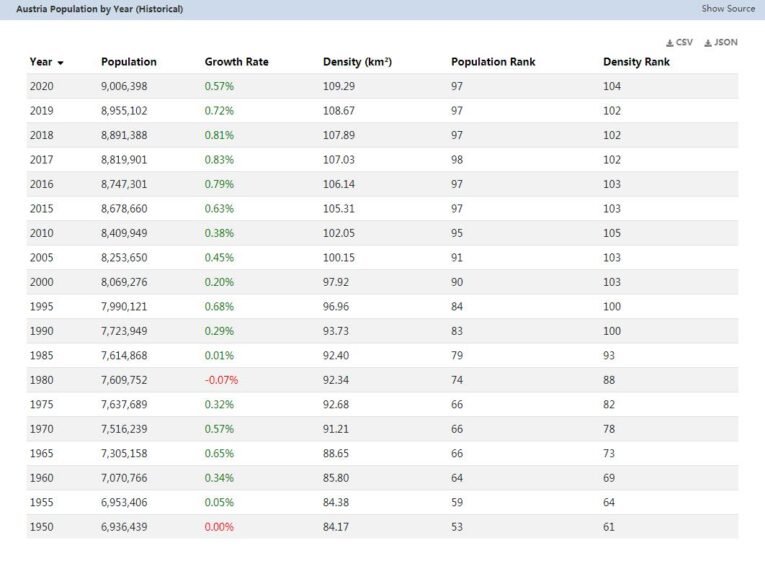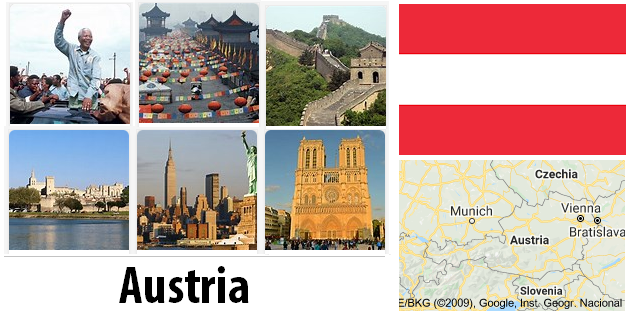AEIOU: the 5 vowels are the initials of the Latin words that form a famous Austrian motto: “Austriae Est Imperare Orbi Universo”, that is “it is the fate of Austria to command the whole world”.
Some traces of huts built on stilts, discovered in the alpine lakes, show that the Austrian region had been inhabited since the Stone Age. The villages rose above all near the lakes and salt mines, sources of wealth and commerce.
Attracted by those natural resources, many peoples invaded the Austrian region: first the Celts, in the 4th century BC, then the Romans, in 113 BC, who created thriving colonies, such as Vindobona (today Vienna) and Juvavum (today Salzburg). In the year 15 after Christ the territory was annexed to Rome.
In the IV century after Christ the territories of the Danubian basin suffered the invasion of German populations, coming from east and north: Huns, Vandals, Goths and Slavs. They annihilated the Latin civilization and imposed their barbaric domination. See Countryaah for population and country facts about Austria.
Population
The natural spatial conditions are reflected in the population distribution: The mountain regions are only populated in lines along the valleys, 70% of the total population of Austria settles in areas below 500 m. In the past few decades the eastern federal states of Styria and Burgenland, and until 1987 even Vienna, suffered slight population losses due to migration to the west. Another migration movement is that from higher-lying settlement areas into the valleys and flatlands. Pronounced tourist regions are an exception here, sometimes only seasonally. Almost 60% of the Alps are virtually uninhabited.
Almost two thirds of all Austrians live in cities. In the Vienna metropolitan areaabout 20% of all residents live. The federal states of Vorarlberg and Upper Austria have the highest population density after Vienna. Cities with a population of more than 100,000 are, apart from Vienna, the cities of Graz, Linz, Salzburg and Innsbruck.
Around 98% of all Austrians are German-speaking, members of minorities are mostly bilingual. These include the Croats and Hungarians in Burgenland, Slovenes in Southern Carinthia and Styria, and around 10,000 Czechs in and around Vienna. The Slovenes and Croats are granted full equality.
Subsequently, upon arrival of Charlemagne, the territory became part of the Franco Kingdom. It was called “Ostmark”, that is “brand”, (border region) eastern of the empire, from which the word “Osterreich” derived, Germanic name of Austria (in German: Kingdom of East).
Other struggles for dominance brought the Hungarians to the country, defeated in turn by the emperorOtto I the Great, king of Germany. Finally, the latter donated the “brand” to Count Leopold of Badenberg, in 976, whose family ruled the country for about three centuries, creating an independent state. The dominion then extended to the east, up to the Danube and Hungary: after a little more than a century the extension of the territory had doubled.
In 1246, with the death of Federico the Battagliero, the Badenberg dynasty died out. Ottocaro II, king of Bohemia, took advantage of this to seize Austria, Styria and Carinthia. But his dominion did not last long: in 1273 Rudolf of Habsburg was elected emperor of Germany, who defeated Ottocaro II and took possession of the territory and settled in Vienna. From that moment and until 1918 the Habsburg House was at the head of Austria, with the two branches of Habsburg and Habsburg-Lorraine.
In 1382, taking Trieste under its protection, Austria secured an outlet to the sea, indispensable for its trade.
With Maximilian I, who reigned from 1493 to 1519, Austria came into possession of Burgundy and the Netherlands brought as a dowry by his wife Maria of Burgundy, daughter of Charles the Fearless.
To secure other domains to the house of Austria, Maximilian I arranged the marriages of his descendants: his son Filippo il Bello married Giovanna la Pazza, daughter of the king of Spain, who inherited the thrones of Castile and Aragon in 1500. Furthermore, two grandchildren married the children of the kings of Bohemia and Hungary.
Upon his death in 1519, Emperor Charles V was elected, son of Philip the Fair and Giovanna the Mad, who was already king of Spain. He divided the empire and entrusted the government of Austria to his brother Ferdinand I, who in 1526 also inherited the kingdoms of Bohemia and Hungary. The whole Carpathian-Danubian region was thus united under one government, which included different populations; Austrians, Bohemians, Hungarians, Slavs. A common faith united them: the Catholic religion, particularly threatened at that time by the Muslims and the Reformation.
The need to defend it brought all these peoples closer and helped to tie them to the house of Austria, which thus became the bulwark of Catholicism. It was in Austria that the Counter-Reformation developed; in Trento, then Austrian city, the famous Council was held and the preaching of the Jesuits spread.
Other events threatened Austria: in 1683 it was attacked by the Turks, but was able to reject them with the help of the king of Poland. The death of King Charles II of Spain, the last Habsburg of the Spanish branch, led to a long succession war with France. Austria lost Spain, receiving in exchange Naples, Milan, Sardinia, which then exchanged with Sicily. Later, with the Polish succession war, he also lost Naples and Sicily, obtaining however the Duchy of Parma and Piacenza and the Grand Duchy of Tuscany.
In 1740 Maria Teresa of the Habsburg-Lorraine branch ascended the throne. She was a great empress; among other things, he tried to improve relations with France by marrying his daughter Marie Antoinette to the Dolphin of France. Under his rule, the state took on new development. Trade increased through the ports of Rijeka and Trieste; he made changes to the laws in favor of the poorest and promoted education among the people.
Towards the end of the 18th century many peoples subject to Austria began to claim their freedoms: the first of these peoples to gain independence was the Belgian people.
After the fall of Napoleon, the Congress of Vienna was called in 1815. The Congress had the task of restoring the balance revolutionized by the Napoleonic wars: Austria was entrusted with the task of guiding Europe towards restoration.
But now all peoples aspired to independence; revolutionary motions occurred in Vienna, Prague, Venice, Milan, Budapest. Austria was going to narrow its borders. With the wars of Italian independence, Lombardy and Veneto lost; in 1867 she was forced to recognize the independence of Hungary.
Serious family misfortunes weakened the reign of Francesco Giuseppe: the suicide of his son Rodolfo, the shooting in Mexico of his brother Massimiliano, the killing of his wife Elisabetta and finally the assassination of his grandson, heir to the throne, Francesco Ferdinando, which took place in Sarajevo (Bosnia ) in 1914, by two Serbian students. To avenge him, Francesco Giuseppe attacked Serbia: other European nations intervened and that was the beginning of the First World War.

